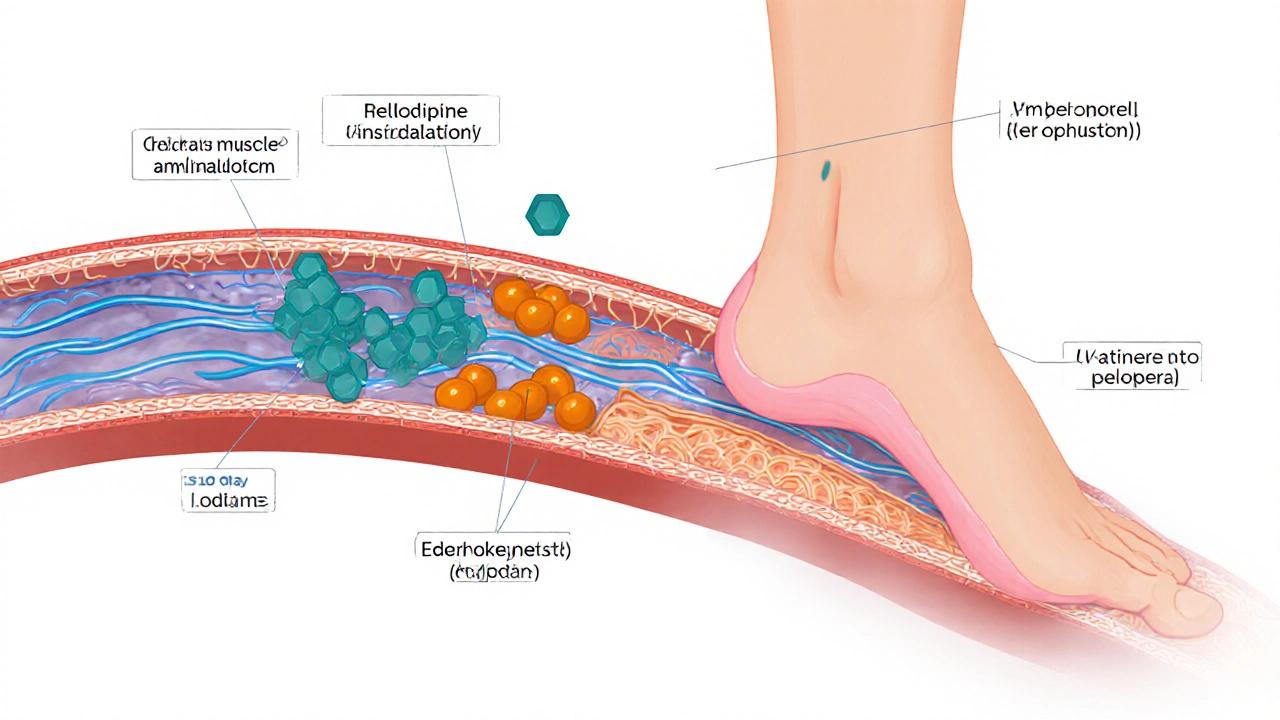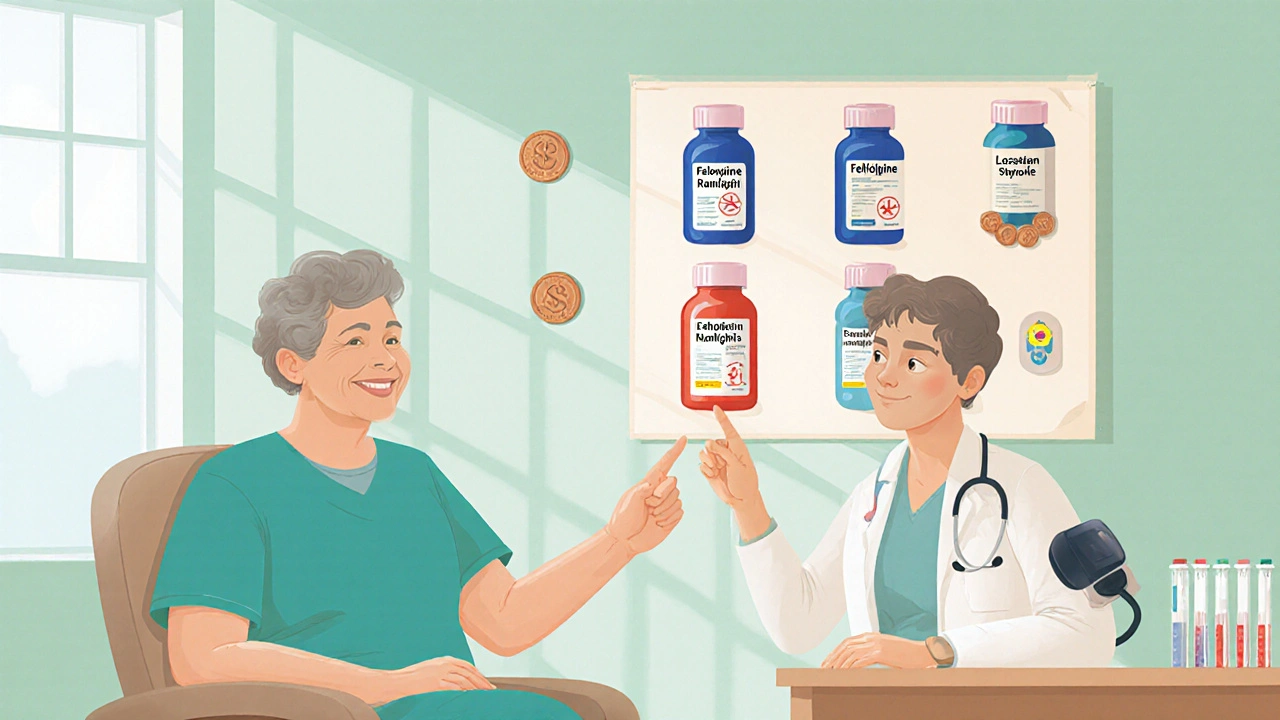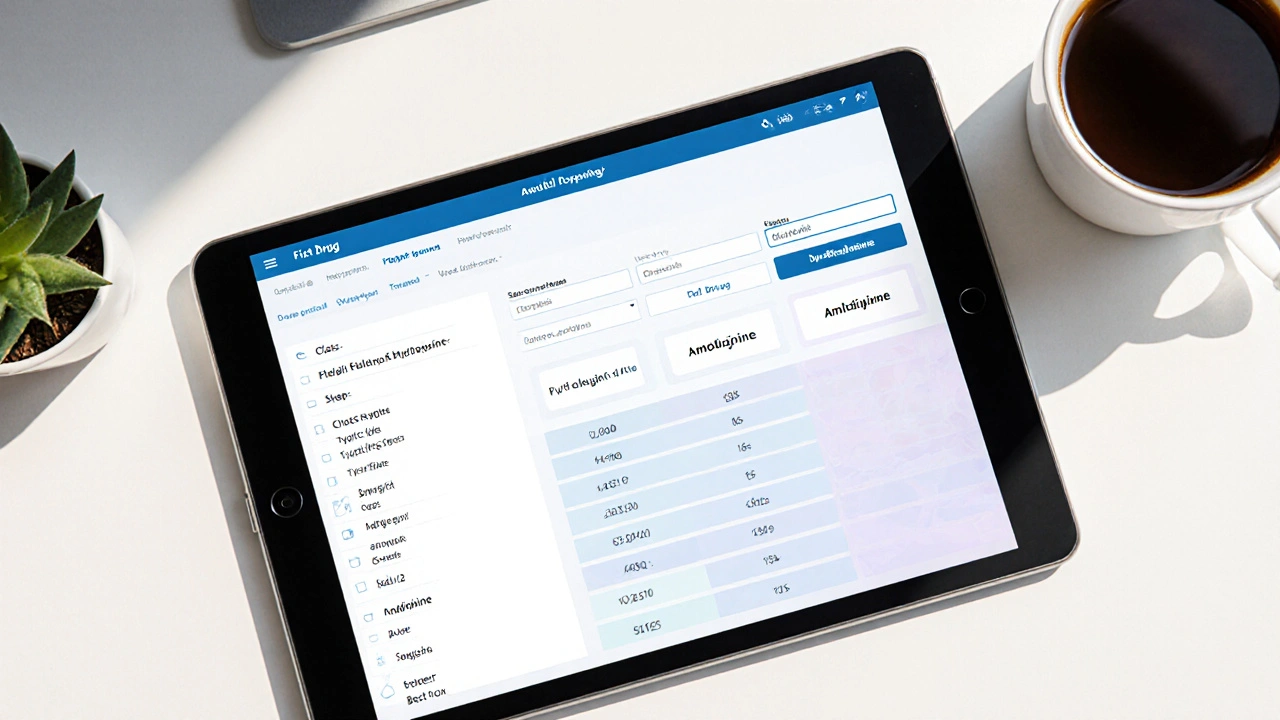Hypertension Drug Comparison Tool
Select Medications to Compare
Quick Summary
- Plendil (Felodipine) is a long‑acting calcium‑channel blocker used for high blood pressure.
- It works slower than amlodipine but offers a smoother blood‑pressure curve.
- Key alternatives include amlodipine, nifedipine, lercanidipine, ramipril, losartan, hydrochlorothiazide, and diltiazem.
- Choose based on half‑life, side‑effect profile, cost, and co‑existing conditions.
- Consult your prescriber before switching - some drugs interact with grapefruit, others affect kidney function.
What is Plendil (Felodipine)?
Felodipine is a long‑acting dihydropyridine calcium‑channel blocker (CCB) that relaxes arterial smooth muscle, lowering peripheral resistance and thus blood pressure. It was first approved in the UK in 1990 and is marketed under the brand name Plendil.
The usual starting dose for adults is 5mg once daily, with a typical maintenance range of 5‑10mg. Because its half‑life is about 20hours, the drug can be taken at any time of day without a strict schedule.
Common side effects include headache, flushing, ankle swelling, and occasional dizziness. These are generally milder than the rapid‑onset CCBs, which can cause a sudden drop in blood pressure.
How to Pick the Right Blood‑Pressure Pill
When comparing any antihypertensive you’ll weigh a handful of practical factors:
- Pharmacokinetics - how quickly the drug works and how long it stays in the body.
- Side‑effect profile - does the drug cause edema, cough, or metabolic changes?
- Comorbidities - kidney disease, diabetes, or heart failure may steer you toward a specific class.
- Cost and availability - generic versions are cheaper but may differ in formulation.
- Drug interactions - grapefruit juice, CYP3A4 inhibitors, or other prescribed medicines can raise or lower levels.
Using these criteria, let’s see how the most common alternatives stack up.

Alternative Hypertension Drugs
Amlodipine is another dihydropyridine CCB, known for its very long half‑life (30‑50hours) and steady blood‑pressure control. It’s often the go‑to when a patient needs a once‑daily pill with minimal dosing fuss.
Nifedipine comes in both immediate‑release (IR) and sustained‑release (SR) forms. The IR version can cause sharp drops in pressure, so the SR version is preferred for hypertension.
Lercanidipine is a newer dihydropyridine that offers a gentle onset and lower incidence of ankle swelling. It’s taken once daily but is slightly more expensive than generic felodipine.
Ramipril belongs to the ACE‑inhibitor class. It works by blocking the conversion of angiotensin I to angiotensin II, reducing vasoconstriction. Ideal for patients with diabetic kidney disease.
Losartan is an angiotensin‑II receptor blocker (ARB). It provides similar blood‑pressure reductions as ACE inhibitors but causes far fewer cough side effects.
Hydrochlorothiazide is a thiazide diuretic that lowers blood volume. Often paired with a CCB or ACE‑inhibitor for synergistic effect, especially in resistant hypertension.
Diltiazem is a non‑dihydropyridine CCB that also slows heart rate. It’s useful when a patient has both high blood pressure and atrial tachyarrhythmia.
Side‑Effect Snapshot
Below is a quick look at the most frequently reported adverse events for each drug.
| Drug | Headache | Ankle Swelling | Cough | Electrolyte Change |
|---|---|---|---|---|
| Felodipine | Common | Occasional | Rare | None |
| Amlodipine | Common | Frequent | Rare | None |
| Nifedipine SR | Common | Frequent | Rare | None |
| Ramipril | Uncommon | Rare | Common (dry cough) | Possible ↑ potassium |
| Losartan | Uncommon | Rare | Rare | Possible ↑ potassium |
| Hydrochlorothiazide | Uncommon | Rare | Rare | ↓ potassium, ↑ uric acid |
| Diltiazem | Common | Rare | Rare | None |
Head‑to‑Head Comparison: Key Attributes
| Attribute | Felodipine (Plendil) | Amlodipine | Nifedipine SR | Lercanidipine | Ramipril | Losartan | Hydrochlorothiazide | Diltiazem |
|---|---|---|---|---|---|---|---|---|
| Class | CCB - dihydropyridine | CCB - dihydropyridine | CCB - dihydropyridine | CCB - dihydropyridine | ACE‑inhibitor | ARB | Thiazide diuretic | CCB - non‑dihydropyridine |
| Typical Dose | 5‑10mg once daily | 5‑10mg once daily | 30‑60mg once daily (SR) | 10‑20mg once daily | 2.5‑10mg once daily | 50‑100mg once daily | 12.5‑25mg once daily | 120‑240mg once daily |
| Half‑Life | ≈20h | 30‑50h | 2‑5h (IR) / 8‑10h (SR) | ≈15h | 12‑15h | 2h (active metabolite 6‑9h) | 6‑15h | 3‑5h |
| Onset of Action | 2‑4h | 2‑4h | 30min (IR) / 2‑3h (SR) | 2‑3h | 1‑2h | 1‑2h | 2‑3h | 1‑2h |
| Cost (UK generic, 2025) | £0.12 per tablet | £0.10 per tablet | £0.08 per tablet | £0.15 per tablet | £0.09 per tablet | £0.09 per tablet | £0.05 per tablet | £0.07 per tablet |
| Best For | Patients needing smoother BP curve, low edema risk | Once‑daily convenience, mild edema tolerance | Those who need rapid control (SR) or already on IR | Patients with prior CCB‑induced edema | Diabetic kidney protection, post‑MI | ACE‑intolerant patients who cough | Resistant hypertension, volume overload | Co‑existing atrial fibrillation or rate control |

When to Pick Felodipine Over the Rest
If you’re looking for a CCB that:
- Provides a steady drop in systolic pressure without a dramatic early dip,
- Has a relatively low incidence of peripheral edema compared with amlodipine,
- Works well in patients on multiple other meds (it has modest CYP3A4 interaction), and
- Is inexpensive as a generic in the UK market,
then felodipine is a solid choice. However, if you have a history of heart failure with reduced ejection fraction, an ACE‑inhibitor or ARB may give additional mortality benefit.
Safety, Interactions, and Monitoring
All antihypertensives need periodic checks. For felodipine, watch these labs:
- Baseline liver enzymes - rare hepatic metabolism issues.
- Serum electrolytes if combined with a diuretic.
- Blood pressure readings at 1, 4, and 12 weeks after initiation.
Key drug‑food interaction: grapefruit juice can raise felodipine levels by up to 30%. Avoid concurrent strong CYP3A4 inhibitors (e.g., clarithromycin) unless dosing is adjusted.
Other CCBs share similar interactions, but non‑dihydropyridine agents (diltiazem, verapamil) also affect cardiac conduction, so they’re contraindicated in certain AV‑block patients.
Frequently Asked Questions
Can I switch from amlodipine to felodipine without a washout period?
Yes. Both are dihydropyridine CCBs, so you can stop amlodipine and start felodipine the same day. Monitor blood pressure for the first week to ensure the new dose controls your numbers.
Why does felodipine cause less ankle swelling than amlodipine?
Felodipine has a smoother plasma‑concentration curve, which reduces the sudden vasodilation that pushes fluid into the lower limbs.
Is felodipine safe in pregnancy?
Calcium‑channel blockers are category C in the UK. They are only used if the benefit outweighs potential risk. Discuss with your obstetrician before starting.
How does felodipine compare to a thiazide diuretic for first‑line therapy?
Guidelines often recommend a CCB or ACE‑inhibitor for black patients, while thiazides work well in many white populations. Felodipine offers better tolerability for patients who dislike frequent urination associated with diuretics.
What should I do if I miss a felodipine dose?
Take the missed tablet as soon as you remember, unless it’s almost time for your next dose. In that case, skip the missed one and continue with your regular schedule. Never double‑dose.
Bottom Line
Felodipine (Plendil) sits comfortably between fast‑acting CCBs like nifedipine and ultra‑long agents like amlodipine. Its moderate half‑life, low edema risk, and cheap UK price make it a go‑to for many adults with uncomplicated hypertension. When comorbidities such as diabetes, heart failure, or severe renal impairment are present, alternatives like ramipril, losartan, or a thiazide diuretic may bring extra benefits.
Always review your personal health profile with a pharmacist or GP before swapping medications. The right drug is the one that fits your life, your labs, and your budget.


Kyle Olsen
October 5, 2025 AT 18:41While the comparison is exhaustive, the utility of such granular cost analysis remains questionable.
Sarah Kherbouche
October 19, 2025 AT 01:14Honestly, this whole chart is just a glorified sales pamphlet-who even cares about £0.12 per tablet when the real issue is the govt’s health policy failures?
MANAS MISHRA
November 1, 2025 AT 06:47I appreciate the thorough breakdown of each class. The side‑effect table makes it easy to see why felodipine might cause less ankle swelling than amlodipine. For patients who are sensitive to edema, the smoother plasma curve of felodipine is a real advantage. The cost difference is minimal, but the half‑life considerations can influence adherence. Also, the interaction note about grapefruit is a useful reminder for clinicians.
Lawrence Bergfeld
November 14, 2025 AT 13:19Great summary! Remember to check electrolytes, especially if you combine with a diuretic, and monitor blood pressure, too!
Chelsea Kerr
November 27, 2025 AT 19:52When it comes to picking a blood‑pressure pill, the decision feels a bit like assembling a puzzle where every piece matters.
Felodipine slides into the picture as a calm, steady player that doesn’t throw you into sudden drops.
Its half‑life of about twenty hours gives a nice daily rhythm without the “yo‑yo” effect that some dihydropyridines cause.
Because the plasma levels rise gradually, patients often report only occasional ankle swelling, a stark contrast to the frequent edema seen with amlodipine.
Cost‑wise, the difference between £0.12 and £0.10 per tablet is hardly noticeable, especially when insurance covers the bulk.
What truly sets felodipine apart is its modest interaction profile-grapefruit will still nudge levels up, but strong CYP3A4 inhibitors are the real culprits.
If you’re already on a thiazide, monitoring electrolytes remains wise, as combining can shift potassium a bit.
From a clinical guideline perspective, CCBs like felodipine are often first‑line for patients of African descent, while ACE‑inhibitors may be favored in diabetics.
That said, if you have heart failure with reduced ejection fraction, an ACE‑inhibitor or ARB often offers mortality benefits beyond blood‑pressure control.
The convenience of once‑daily dosing cannot be overstated; fewer pills usually means better adherence.
Patients who value a smooth evening blood‑pressure curve might even take the dose at night without fearing a morning dip.
On the flip side, those who are prone to dizziness should start low and watch for orthostatic changes.
Overall, the evidence suggests felodipine is a solid, middle‑ground choice for uncomplicated hypertension.
It balances efficacy, tolerability, and price without the dramatic side‑effect spikes of some alternatives.
Bottom line: pick the drug that matches your lifestyle, comorbidities, and budget, and keep the conversation open with your prescriber. 😊
Tom Becker
December 11, 2025 AT 02:25Look, the pharma giants don’t want you to know that felodipine was originally designed as a back‑up for amlodipine, a fact they buried in old patents. They push the newer brand names while keeping the cheap generic out of the spotlight. And don’t even get me started on the hidden grapefruit clause-someone’s definitely profiting off those tiny percentage bumps. Stay woke!
Laura Sanders
December 24, 2025 AT 08:58Felodipine's pharmacokinetics are superior in terms of half‑life and edema profile compared to amlodipine